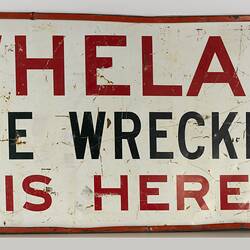Summary
Tall metal and glass advertising sign in the form of a giant thermometer, made by H.C. Stephens Co. of Aldersgate Street, London, 1920s. The sign advertises Stephens Inks 'for all temperatures'. It appears that the thermometer contains mercury in the tube and actually works. According to the donor, Myles Whelan, this advertising display 'had hung inside the office of Whelan the Wrecker since the 1920s.' It was probably obtained from the internal fittings of a commercial building in Melbourne that Whelans demolished. Mr Whelan donated the sign to Museum Victoria after the company went into receivership in 1991.
'Stephens' Ink' was invented by the British physician, Dr Henry Stephens (1796-1864), who in 1832 first developed his indelible "blue-black writing fluid" that became the basis of a successful manufacturing enterprise lasting over 130 years. Stephens' ink revolutionised office life in the latter half of the 19th century saving clerical workers much time previously spent mixing powdered inks and cleaning nibs. Being indelible and non-fading, Stephens' ink was made mandatory by the British government for all for legal documents and ships' log books.
In 1848, Dr Stephens moved production of his inks to Finchley in North London, were he bought and renovated Grove House, establishing a laboratory amongst the outbuildings for his personal research into new recipes for making inks and wood stains. After Dr Stephens collapsed and died at Farringdon Station in 1864, the business was taken over by his son Henry Charles Stephens (1841-1918) who turned the business into an international operation, making 'Stephens' Ink' a household name throughout the world. In the early 1880s, the ink factory and offices of H.C. Stephens moved from Aldersgate Street, London, to 275 Holloway Road, Holloway, and then in 1892 the factory moved again to nearby Gillespie Road. Popularly known as "Inky" Stephens, Henry Charles served as a conservative British MP from 1887-1900 and was a prominent local figure around Finchley. In 1874 he bought Avenue House at Finchley, with 10 acres of adjoining land that he turned into extensive gardens and upon his death bequeathed the house and grounds to the local community - it today operates as a museum housing the Stephens Collection.
Imported Stephens' Ink was being advertised in Australian newspapers as early as the 1850s. The company exhibited at the Sydney International Exhibition of 1879 and later established a distribution office in Sydney that was managed by William Mould in the early 20th century. After changes to the Australian import duties on inks, a local manufacturing works was established in the early 1930s by Stephens Inks (Australia) Ltd. and in 1935, the company had a new two storey factory designed by architects B.B. Wilshire & N. Hodges built on the Pacific Highway, North Sydney. The ink was sold in locally-made glass bottles that remained the property of the company and were collected for reuse.successful worldwide company for over 130 years.
Physical Description
Tall metal and glass advertising sign, containing a thermometer. The sign advertises Stephens Inks 'for all temperatures'. The thermometer ranges from 0 degrees to 140 degrees fahrenheit and is marked off at the appropriate temperature: 'Fever Heat' (110), 'Summer Heat' (75), 'Temperate' (55), 'Freezing' (32) and 'Zero' (0). The sign is enamelled in white paint with black writing. A label on the back indicates that the thermometer was 'For outside exhibit only'.
More Information
-
Collection Names
-
Collecting Areas
-
Acquisition Information
Donation from Mr Myles Whelan, 23 Jun 1992
-
Maker
H.C. Stephens, London, England, Great Britain, circa 1920
Sign advertises Stephens Inks -
Place Used
Whelan the Wrecker, 605 Sydney Road, Brunswick, Greater Melbourne, Victoria, Australia, circa 1920s-1980s
-
Inscriptions
Printed: Stephens'/Inks/140-0/Fever/Heat/Blood/Heat/Summer/Heat/Temp/rate/ Freez/ing/Zero/for all/Temperatures/Stephens/Inks. On back: For outside exhibit only. (Extensive text).
-
Brand Names
-
Classification
Commerce & retailing, Stationery & office supplies, Advertising
-
Category
-
Discipline
-
Type of item
-
References
Wikipedia, Henry Charles Stephens, [Link 1] accessed 11/01/2012.
-
Keywords
Working Life, Advertisements, Advertising Signs, Writing Equipment, Inks


